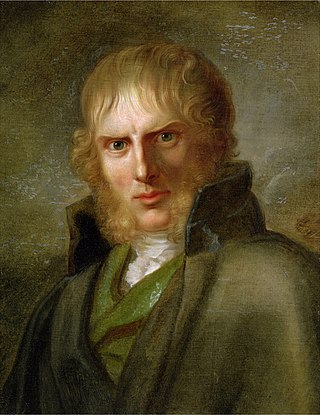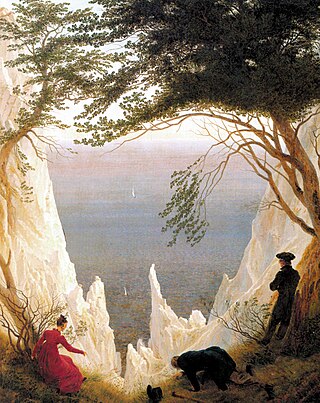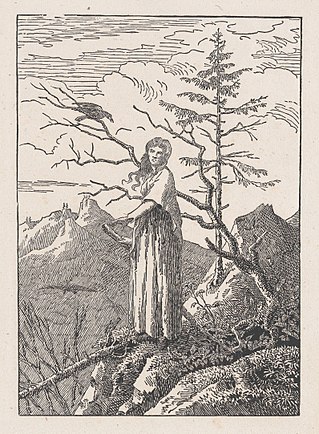
Caspar David Friedrich was a German Romantic landscape painter, generally considered the most important German artist of his generation, whose often symbolic, and anti-classical work, conveys a subjective, emotional response to the natural world. Friedrich's paintings often set contemplative human figures silhouetted against night skies, morning mists, barren trees or Gothic ruins. Art historian Christopher John Murray described their presence, in diminished perspective, amid expansive landscapes, as reducing the figures to a scale that directs "the viewer's gaze towards their metaphysical dimension".

Wanderer above the Sea of Fog is a painting by German Romanticist artist Caspar David Friedrich made in 1818. It depicts a man standing upon a rocky precipice with his back to the viewer; he is gazing out on a landscape covered in a thick sea of fog through which other ridges, trees, and mountains pierce, which stretches out into the distance indefinitely.

Chalk Cliffs on Rügen is an oil painting of circa 1818 by German Romantic artist Caspar David Friedrich.

The Abbey in the Oakwood is an oil painting by the German Romantic artist Caspar David Friedrich. It was painted between 1809 and 1810 in Dresden and was first shown together with the painting The Monk by the Sea in the Prussian Academy of Arts exhibition of 1810. On Friedrich's request The Abbey in the Oakwood was hung beneath The Monk by the Sea. This painting is one of over two dozen of Friedrich's works that include cemeteries or graves.

The Sea of Ice, (1823–1824), is an oil painting that depicts a shipwreck in the Arctic by the German Romantic painter Caspar David Friedrich. Before 1826 this painting was known as The Polar Sea.

Caspar David Friedrich in his Studio refers to two paintings by the German romantic artist Georg Friedrich Kersting dated 1811 and 1819. Of these the 1819 version, now in the Alte Nationalgalerie in Berlin, is the best known. In both Kersting depicted fellow German painter Caspar David Friedrich in his studio.

The Tree of Crows is an oil painting by the German Romantic artist Caspar David Friedrich, from 1822. Acquired by the Louvre in 1975, it has been called one of Friedrich's "most compelling paintings." The painting depicts a twisted oak tree, bare but for a few dead leaves, seen against an evening sky. An inscription on the back of the canvas refers to the hill at the painting's center as a Hünengrab, or dolmen, a prehistoric burial ground. In the distance can be seen the ocean, and Cape Arkona's chalk cliffs, a favorite subject of Friedrich's. Two crows are perched on the oak, while a flock descends toward it. In the darkened foreground are a hacked trunk and the upright stump of another oak.

Two Men Contemplating the Moon and Man and Woman Contemplating the Moon are a series of similar paintings by Caspar David Friedrich, the setting being among his best-known works. Friedrich painted at least three versions, with one variation featuring a man and a woman. The 1819–20 version in the Galerie Neue Meister is thought to be the original; the c. 1824 variant with a woman is in the Alte Nationalgalerie; and the c. 1830 version is in the Metropolitan Museum of Art.

Cairn in Snow, also known as Dolmen in the snow, is a landscape painting by the German painter Caspar David Friedrich. Friedrich is noted for his landscapes depicting features such as trees or Gothic ruins, silhouetted against the sky or in morning mists. The painting depicts leafless trees in the winter snow, with the tops of two of the trees broken off and the third bent by the prevailing wind, giving the work a haunted, spectral air. It is a Romantic allegorical landscape, depicting a stone cairn or dolmen set amid three oak trees on a hilltop, with a contemplative melancholy mood. It was probably painted around 1807, making it among Friedrich's first oil paintings. It measures 61 by 80 centimetres and has been held by the Galerie Neue Meister in Dresden since 1905.

Cross in the Mountains, also known as the Tetschen Altar, is an oil painting by the German artist Caspar David Friedrich designed as an altarpiece. Among Friedrich's first major works, the 1808 painting marked an important break with the conventions of landscape painting by including Christian iconography. In the hierarchy of genres, religious (history) painting was considered the highest genre of art; Friedrich's use of landscape to evoke a spiritual message was thus controversial, causing debate between proponents of neoclassical ideals and the new German Romanticism of Friedrich and his peers.

Morning on the Riesengebirge is an 1810–1811 painting by the German Romantic artist Caspar David Friedrich of a scene on the Riesengebirge. It was exhibited at the Dresden Academy, where it attracted significant public attention. The painting was then acquired in 1811 by Frederick William III of Prussia for Unter den Linden, his Berlin palace, where it remained until 1837, when it was moved to the New Palace in Potsdam.

Woman at a Window is an 1822 oil painting by the German Romantic artist Caspar David Friedrich. This painting is currently located in Alte Nationalgalerie, Berlin. The painting depicts an interior with a woman, seen from behind, peering out an opened window. Beyond the window, the masts of ships are visible. The woman in the piece is Friedrich's wife Caroline and the view from the window is from his studio overlooking the Elbe river in Dresden. Friedrich submitted his work to be exhibited at the Dresden Academy, however he did not complete the piece in time to be in the main exhibition.

The Watzmann is an 1824-1825 oil on canvas painting by Caspar David Friedrich, showing the Watzmann mountain as seen from Berchtesgaden to the north-east. It is now on display in the Alte Nationalgalerie in Berlin.

Woman with a Raven at an Abyss is a c. 1803/04 print by the German Romantic painter Caspar David Friedrich, made into a woodcut by his brother Christian Friedrich, a carpenter and furniture maker, around the same time.

Italia und Germania is an allegorical painting of the painter Friedrich Overbeck, finished in 1828. The painting shows two women inclining to each other, symbolizing the friendship between the two countries or cultures they represent: Italia and Germania. At that time, both Italy and Germany were cultural regions but not unified national states.

Evening is an 1821 oil on canvas painting by Caspar David Friedrich, now in the Niedersächsischen Landesmuseum Hannover. With Morning, Midday and Afternoon, it forms a series on different times of day.

The Gazebo or The Garden Bower is an 1818 oil on canvas painting by Caspar David Friedrich, now in the Neue Pinakothek, in Munich.

The Great Enclosure or The Ostra Enclosure (Ostra-Gehege) is an 1831 oil-on-canvas painting by Caspar David Friedrich, now in the collection of the Albertinum of the Galerie Neue Meister, in Dresden.

Hutten's Grave (1823) is an oil on canvas painting by Caspar David Friedrich, showing a man in Lützow Free Corps uniform standing by the grave of the Renaissance humanist and German nationalist Ulrich von Hutten. Influenced heavily by the political climate of the time and Friedrich's own political beliefs, the painting is one of Friedrich's most political works and affirms his allegiance to the German nationalist movement. The painting was made to commemorate the 300th anniversary of Hutten's death and the 10th anniversary of Napoleon's invasion of Germany. It is now in the Klassik Stiftung Weimar's collection and on show in the Schlossmuseum at the Stadtschloss Weimar.

The Temple of Juno in Agrigento is an 1828-1830 oil on canvas painting of by Caspar David Friedrich. It is now in the Museum für Kunst und Kulturgeschichte, in Dortmund, which bought it from a Cologne art dealer in 1951. It is said to have been previously owned by the F. A. Brockhaus publishers in Leipzig.





















